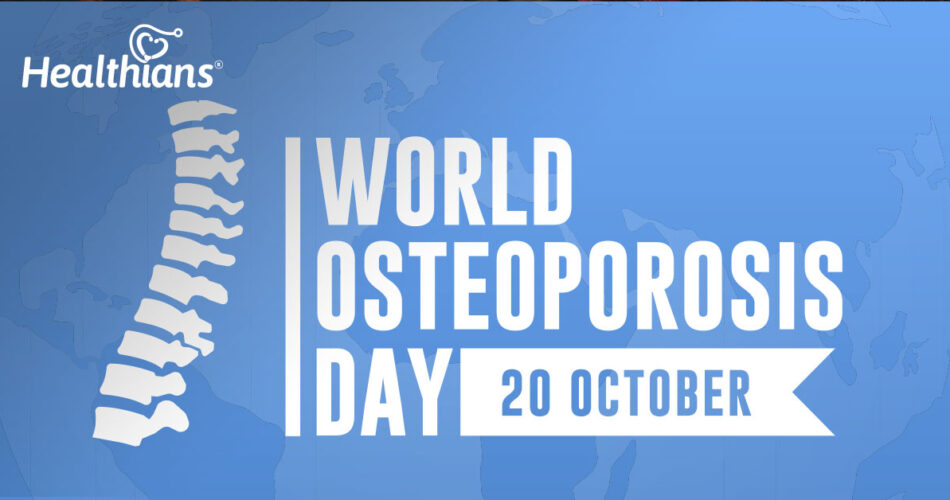Contributed by: Healthians Team
Introduction
Osteoporosis literally translates to ‘porous bone.’ Since the condition weakens bones, increases it your chance of abrupt, unforeseen bone fractures. If you have osteoporosis, your bones are weaker and have less mass.
The condition frequently progresses without any warning signs or discomfort, and it is typically not recognised until the weakening bones result in excruciating fractures. The majority of them include hip, wrist, and spine fractures.
Read further to know the risk factors, diagnosis, and treatment for osteoporosis.
What are the symptoms of osteoporosis?
Osteoporosis typically shows no symptoms. It is sometimes referred to as a quiet sickness for this reason. However, be on the lookout for the following:
- Reduction in height (getting shorter by an inch or more)
- Adaptation of posture (stooping or bending forward)
- Breathing difficulty (smaller lung capacity due to compressed disks)
- Broken bones
- Lower back hurts
Who is at risk of getting osteoporosis?
Two of the most important risk factors for osteoporosis are gender and age, which together account for a wide range of risk variables.
Age
Age raises everyone’s risk for osteoporosis fractures. However, the risk of getting osteoporosis is highest in postmenopausal women over the age of 50. Because menopause inhibits the production of oestrogen, a hormone that prevents excessive bone loss, women have accelerated bone loss in the first 10 years after menopause.
Weight
Bone structure and body weight are further factors. People who are skinny have less bone to shed than people with higher body weight and larger frames, therefore they are more likely to develop osteoporosis.
Family history
Risk factors for osteoporosis can include family history. You may be at a higher risk of having osteoporosis if your parents or grandparents have displayed any symptoms of the condition, such as a hip fracture following a small fall.
Medical issues
Last but not the least, some medical problems and drugs raise your risk. You and your healthcare provider might think about early osteoporosis screening if you currently have or formerly had any of the illnesses listed below, some of which are connected to abnormal hormone levels.
- An overactive thyroid, parathyroid, or adrenal glands.
- History of bariatric (weight loss) surgery or organ transplant.
- Celiac disease, or inflammatory bowel disease.
- Blood diseases such as multiple myeloma.
- Hormone treatment for breast or prostate cancer or a history of missed periods.
How is osteoporosis diagnosed?
In order to find out about your bone health before issues arise, your doctor may conduct a test. Dual-energy X-ray absorptiometry, often known as a DEXA or DXA scan, is another name for bone mineral density (BMD) examinations.
The strength of the spine, hip, and wrist bones may be examined using these X-rays, which emit extremely modest doses of radiation. Only highly advanced osteoporosis will be shown on routine X-rays.
A bone density test needs to be performed on all women over the age of 65. For females who have osteoporosis risk factors, the DEXA scan may be performed sooner. Consider obtaining a bone density test if you’re over 70 or someone younger but with risk factors.
Foods to avoid if you have osteoporosis
Alcohol
Bone health can be negatively impacted by alcohol.
Alcohol has a negative impact on the body’s capacity to absorb calcium and vitamin D, according to the National Institute of Arthritis and Musculoskeletal and Skin Diseases (NIAMSD). Chronic excessive drinking can also lead to hormonal changes that affect how well bones develop and break down.
As a result, those who have osteoporosis may want to think about reducing their alcohol consumption.
Soda and cold drinks
Cola consumption is linked to reduced bone mass. Although the displacement of dairy beverages high in calcium may be the main problem, there may also be a direct effect. Colas usually have a high caffeine content and excessive intake may significantly increase the risk of bone loss.
Sodium-packed foods
Due to increased calcium excretion, a high salt diet may exacerbate osteoporosis. So, if you want to maintain a high level of bone mass, be sure to cut back on your salt intake.
Additionally, exercise and physical activity over the course of a person’s life support bone health. Weight-bearing workouts improve bone strength and remodelling.
Final thoughts
Every year 20th October is acknowledged as World Osteoporosis Day worldwide. To spread awareness among the population about this medical illness, this day is observed.
In this article, we have covered different aspects of osteoporosis which would have provided you with risk factors, diagnosis, and foods to avoid if you have osteoporosis.
If you have osteoporosis, talk to your doctor. Examine each possible treatment and lifestyle change. Together, you can decide on a treatment plan that’s best suited for you.




